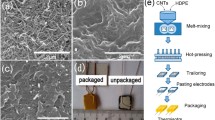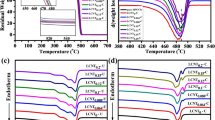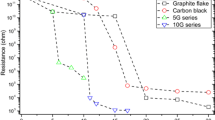Abstract
Good temperature sensing properties from room temperature up to 100 °C have been obtained, with high density polyethylene/carbon nanotube composites even for nanotube concentrations slightly above the percolation threshold in the case that oxidized multi-walled carbon nanotubes have been used. Due to the low conductivity no Joule heating has to be considered.
Access provided by CONRICYT-eBooks. Download conference paper PDF
Similar content being viewed by others
Keywords
1 Introduction
Carbon nanotube based temperature sensors with electrical readout have been realized in a great variety of geometries, ranging from very small sensors, based on the temperature dependence of the single nanotube conductivity [1], up to large area sensors, based on carbon nanotube networks, often embedded into a matrix material. The matrix material can range from hydrogel [2] to polymers [3], epoxy resins [4, 5] or even biological cells [6]. The sensing properties depend on the type of carbon nanotubes [7], their concentration [8] the matrix material [9] and last, but not least, the electrical contact material and geometry [10]. It should be mentioned that, even for the same type of nanotube networks, as well positive temperature coefficient (PTC) [11, 12] as negative temperature coefficient (NTC) [5] behaviour has been observed. Combining different layers with PTC and NTC effect, zero temperature coefficient (TC) material can be obtained [13]. Recently, however, it has been shown that nanocomposite material with near zero TC can also be obtained by a simple one-layer flexible thin film of poly-(amide-imide) highly loaded with carbon black with applications as high temperature, flexible electrical heater foil without need for temperature compensation [14]. Applying high voltages to nanocomposite based temperature sensors with nanoparticle concentrations far above the electrical percolation threshold, Joule heating has to be taken into account. This effect can be exploited for the realization of current limiting devices [15]. On the other hand Joule-heating can modify the contact properties [16] and hence lead to an instability of the sensing characteristics. Therefore it can be of interest to realize low-conductance temperature sensors, using for example polymer/CNT composites with CNT concentrations slightly above percolation threshold. It should be mentioned, that in the case of LLDPE/CNT composites also high electric fields during high temperature cycling can lead to conductivity changes of the composite sample [17]. Here we report on the realization of high density polyethylene (HDPE)/multi-walled carbon nanotube (MWCNT) based temperature sensors with low conductance and their sensing properties for relatively high temperatures from room temperature up to 100 °C. In order to favour a more homogeneous nanotube distribution, oxidized MWCNTs have been used [18].
2 Experimental
2.1 Sample Preparation
High-density polyethylene (HDPE0390) (Qenos) with an average molecular weight of Mw ~ 58.886 g/mol and polydispersity of 5.8 was chosen as matrix. Multi-walled carbon nanotubes (MWNTs) were synthesized by chemical vapor deposition at CSIRO (Commonwealth Scientific and Industrial Research Organization, Australia) with an average diameter of 50 nm. Non-functionalized (MWNTs) and functionalized (OXI MWNTs) carbon nanotubes were used. The functionalization treatment consists of oxidative treatment in a tube furnace at 500 °C for 1 h, in a 95% nitrogen and 5% oxygen atmosphere.
Nanocomposites with different nanotube concentrations (between 0.5 and 7 wt%) in the HDPE matrix (named MWNT/HDPE and OXI MWNT/HDPE) were prepared by melt mixing in a micro-twin screw extruder (Haake MiniLab Rheomex CTW5). Thanks to a re-circulating channel, this extruder is capable of cycling the melt, ensuring a good mixing and making good-quality samples from a limited amount of material. Each nanocomposite was mixed for 10 min, with a screw speed of 50 rpm. Finally coplanar gold electrodes have been evaporated on the top of the samples. In this work we report exclusively on the samples with a CNT concentration of 2.5 wt%.
2.2 Structural Sample Characterization
In order to analyse the dispersion of the filler in the polymeric matrix, the samples were investigated by means of scanning electron microscopy (SEM). A typical SEM images of the etched fracture surface of the HDPE/CNT composite with 2.5 wt% oxidized MWCNTs is shown in Fig. 1. The image demonstrates a homogeneous dispersion of the carbon nanotubes in the sample.
It should also be mentioned that rheological and electrical measurements have shown that the HDPE/MWCNT nanocomposites with 2.5 wt% carbon nanotube content are above the percolation threshold, independently of the surface treatment of the nanotubes [19].
2.3 Measurement Setup for the Temperature Dependent Electrical Characterization
The electrical measurements of the HDPE/MWCNT composites, reported in this paper, have all been performed in a 2-point contact geometry using a Keithley model “2400” Source-Measurement-Unit (SMU). For the temperature dependent conductivity measurements, the samples have been subjected to slow temperature cycles in an electronically regulated oven. The oven temperature has been measured using a thin-film thermo-element, positioned on top of the composite sample, to be characterized.
In a previous work it has been shown, that these composite type has a percolation threshold of the electrical conduction and of the rheological properties between 1 and 2.5 wt% addition of CNTs to the polymer matrix [19, 20]. In the case of highly conducting samples of this kind of composites (CNT concentrations of 5 and 7 wt%) have been shown to have a variety of interesting applications for low temperature sensing [21], current limiting [22] and microwave shielding [23].
Here we investigated the temperature sensing properties above room temperature up to 100 °C of a low CNT concentration composite sample (2.5 wt% of MWCNTs) with oxidized nanotubes. It has been shown, that the oxidation lowers the conductivity by some orders of magnitude as compared to the samples with non-oxidized CNTs. Often it is found that low-conductivity polymer/CNT composites have rather instable characteristics due to the low number of percolation paths involved in the conduction.
3 Results and Discussion
The current-voltage characteristics of the investigated HDPE/CNT composite sample with 2.5 wt% oxidized MWCNTs (see Fig. 2) is not linear, as shown earlier for the case of the high conductance samples [5], but after an initial burn-in procedure rather stable. Typically we found conductivity values of about 1 × 10−6 S/cm for the samples with 2.5 wt% of non-oxidized MWCNTs and values of about 5 × 10−9 S/cm for the samples with 2.5 wt% of oxidized MWCNTs.
Measuring the sample current and temperature (applied voltage: 100 V) during multiple temperature cycling above room temperature for a sample with non oxidized and a sample with oxidized multi walled carbon nanotubes with the same concentration of 2.5 wt% (see Fig. 3), we observed a very unstable characteristics in the case of the sample with non-oxidized CNTs (Fig. 3a). In particular for this sample during the cooling period a non-monotonic behaviour, sharp switching and a successively with increasing cycle number decreasing sensitivity has been found.
For the sample with the oxidized CNTs, however, a rather stable characteristics, as it can be seen in Fig. 3b, was obtained. Only after the first cycle we see a small decrease of the conductivity, that remains further on stable. In this latter case, during the cooling periods a monotonic increase of the conductivity with increasing temperature can be observed.
Because the cooling process, however, was very slow, it can be assumed that the sample is in thermal equilibrium during cooling and hence sample and thermo-element temperature coincide. A good reproducibility of the current-temperature traces during cooling for all the cycles is observed. This confirms that not only the current-voltage characteristics, but also the sample resistance-temperature characteristic has a good stability.
The same monitoring has been also performed for smaller voltages. In Fig. 4 the temperature-conductivity relation of the nanocomposite, as measured during the last cooling cycle has been plotted for different applied voltages of 100 and 10 V. For comparison, the conductivities have been normalized to their value at 30 °C. We see a very smooth characteristics for the 100 V curve and a much more noisy characteristics with slightly different behaviour for the curve, taken at 10 V. This has been most probably to be attributed to interface problems either between nanotubes and the metallization or to noisy intertube connections. As it is also seen in the inset of Fig. 4 the characteristics, measured at 100 and 10 V, can be nicely fitted by 3rd order polynomial fits. The sensitivity of the sample is higher than the one previously reported for highly conductive epoxy/CNT [5].
4 Conclusions
It has been shown that stable temperature sensors for the temperature range up to 100 °C can be realized with low-conductance high density polyethylene/carbon nanotube composites, realized with oxidized multi-walled carbon nanotubes with a filler-concentration of 2.5 wt% and evaporated gold contacts, whereas composites with the same filler-concentration of non-oxidized carbon nanotubes a higher conductivity could be achieved but no stable temperature sensing was possible.
References
Y. Arai, C. Ng, P. Liu, L. Dong, Y. Imaizumi, K. Maeda, H. Maruyama, A. Ichikawa, T. Kukuda. Ultra-small site temperature sensing by carbon nanotube thermal probes, in Proceedings of the 4th IEEE Conference on Nanotechnology, (2004), 146–148
E. Manek, B. Berke, N. Miklósi, M. Sajbán, A. Domán, T. Fukuda, O. Czakkel, K. László, Thermal sensitivity of carbon nanotube and graphene oxide containing responsive hydrogels. Exp. Polym. Lett. 10, 710–720 (2016)
C. Barone, S. Pagano, H.C. Neitzert, Transport and noise spectroscopy of MWCNT/HDPE composites with different nanotube concentrations. J. Appl. Phys. 110, 113716 (2011)
Y. Alamusi, N. Li, L. Hu, W. Wu, X. Yuan, B. Peng, C. Gu, Y. Chang, H. Liu, J. Ning, S. Li, S. Atobe, H. Fukunaga, Temperature-dependent piezoresistivity in an MWCNT/epoxy nanocomposite temperature sensor with ultrahigh performance. Nanotechnology 24, 455501 (2013)
H.C. Neitzert, L. Vertuccio, A. Sorrentino, Epoxy/MWCNT composite as temperature sensor and electrical heating elements. IEEE Trans. Nanotechnol. 9, 688–693 (2010)
R. Di Giacomo, B. Maresca, A. Porta, P. Sabatino, G. Carapella, H.C. Neitzert, Candida albicans/MWCNTs: a stable conductive bionanocomposite and its temperature sensing properties IEEE Trans. Nanotechnol. 12, 111–114 (2013)
A. Naeemi, J.D. Meindl, Physical modeling of temperature coefficient of resistance for single- and multi-wall carbon nanotube interconnects. IEEE Electron Dev. Lett. 28, 135–138 (2007)
C. Barone, G. Landi, C. Mauro, H.C. Neitzert, S. Pagano, Universal crossover of the charge carrier fluctuation mechanism in different polymer/carbon nanotubes composites. Appl. Phys. Lett. 107, 143106 (2015)
W.R. Fahrner, G. Landi, R. Di Giacomo, H.C. Neitzert. Multi-walled carbon nanotube network-based sensors and electronic devices, in The Nano-Micro Interface: Bridging the Micro and Nano Worlds, eds. by H.-J. Fecht, M. Werner, M. Van de Voorde, (Wiley-VCH, Verlag, 2015), pp. 225–242
H.C. Neitzert, G. Landi. Influence of the contact metallization on the characteristics of resistive temperature sensors based on EPOXY/MWCNT composites, Chapter 58, in Sensors, Proceedings of the Second National Conference on Sensors, Rome 19–21 February, 2014 Series. Lecture notes in electrical engineering, vol. 319, (Springer, Berlin, 2015), pp. 333–337
X.L. He, J.H. Du, Z. Ying, H.M. Cheng, X.J. He, Positive temperature coefficient effect in multiwalled carbon nanotube/high-density polyethylene composites. Appl. Phys. Lett. 86, 062112 (2005)
S.P. Bao, G.D. Liang, S.C. Tjong, Positive temperature coefficient effect of polypropylene/carbon nanotube/montmorillonite hybrid nanocomposites. IEEE Trans. Nanotechnol. 8, 729–736 (2009)
K. Chu, S.C. Lee, S. Lee, D. Kim, C. Moon, S.H. Park, Smart conducting polymer composites having zero temperature coefficient of resistance. Nanoscale 7, 471–478 (2015)
S. Liparoti, G. Landi, A. Sorrentino, V. Speranza, M. Cakmak, H.C. Neitzert, Flexible poly(amide-imide)-carbon black based microheater with high-temperature capability and an extremely low temperature coefficient. Adv. Electron. Mater. 2, 1600126 (2016)
H.C. Neitzert, O. Valentino, M. Sarno, M.R. Nobile, P. Ciambelli, PTC elements based on high density polyethylene loaded with multi-walled carbon nanotubes, in Proceedings of the 7th International Conference on Nanostructured Polymers and Nanocomposites (ECNP), Prague, 24–27 April 2012, pp. 383–385
Y. Woo, G.S. Duesberg, S. Roth, Reduced contact resistance between an individual single-walled carbon nanotube and a metal electrode by a local point annealing. Nanotechnology 18, 095203 (2007)
M. Ferrara, H.C. Neitzert, M. Sarno, G. Gorrasi, D. Sannino, V. Vittoria, P. Ciambelli, Influence of the electrical field applied during thermal cycling on the conductivity of LLDPE/CNTs composites. Phys. E 37, 66 (2007)
M.R. Nobile, E. Somma, O. Valentino, G. Simon, H.C. Neitzert, Influence of the nanotube oxidation on the rheological and electrical properties of CNT/HDPE composites. AIP Conf. Proc. 1736, 020150 (2016)
Olga Valentin, PhD thesis, Salerno (2008)
O. Valentino, M. Sarno, N.G. Rainone, M.R. Nobile, P. Ciambelli, H.C. Neitzert, G.P. Simon, Influence of the polymer structure and nanotube concentration on the conductivity and rheological properties of polyethylene/CNT composites. Phys. E 40, 2440–2445 (2008)
C. Barone, S. Pagano, H.C. Neitzert, Effect of concentration on low-frequency noise of multiwall carbon nanotubes in high-density polyethylene matrix. Appl. Phys. Lett. 97, 152107 (2010)
H.C. Neitzert, O. Valentino, M. Sarno, M.R. Nobile, P. Ciambelli, PTC elements based on high density polyethylene loaded with multi-walled carbon nanotubes, in Proceedings of the 7th International Conference on Nanostructured Polymers and Nanocomposites (ECNP), Prague, 24–27 April (2012), pp. 383–385
R. Di Giacomo, H.C. Neitzert, HDPE/MWCNT composite as microwave absorber. AIP Conf. Proc. 1593, 282–285 (2014)
Acknowledgements
The authors thank Prof. Dr. George P. Simon from Monash University (Australia) for the CNT and composite preparation and Dr. Olga Valentino from Polimeri Europa for the composite sample preparation and the structural characterization.
Author information
Authors and Affiliations
Corresponding author
Editor information
Editors and Affiliations
Rights and permissions
Copyright information
© 2018 Springer International Publishing AG
About this paper
Cite this paper
Neitzert, HC., Landi, G., Nobile, M.R. (2018). Temperature Sensing Properties of High Density Polyethylene Loaded with Oxidized Multi Walled Carbon Nanotubes. In: Andò, B., Baldini, F., Di Natale, C., Marrazza, G., Siciliano, P. (eds) Sensors. CNS 2016. Lecture Notes in Electrical Engineering, vol 431. Springer, Cham. https://doi.org/10.1007/978-3-319-55077-0_6
Download citation
DOI: https://doi.org/10.1007/978-3-319-55077-0_6
Published:
Publisher Name: Springer, Cham
Print ISBN: 978-3-319-55076-3
Online ISBN: 978-3-319-55077-0
eBook Packages: EngineeringEngineering (R0)








